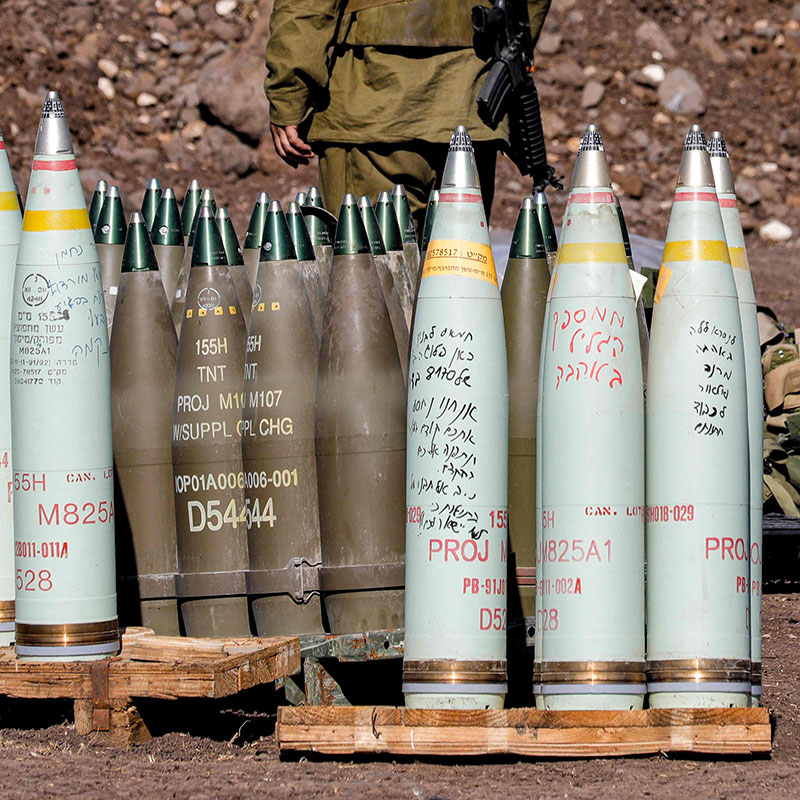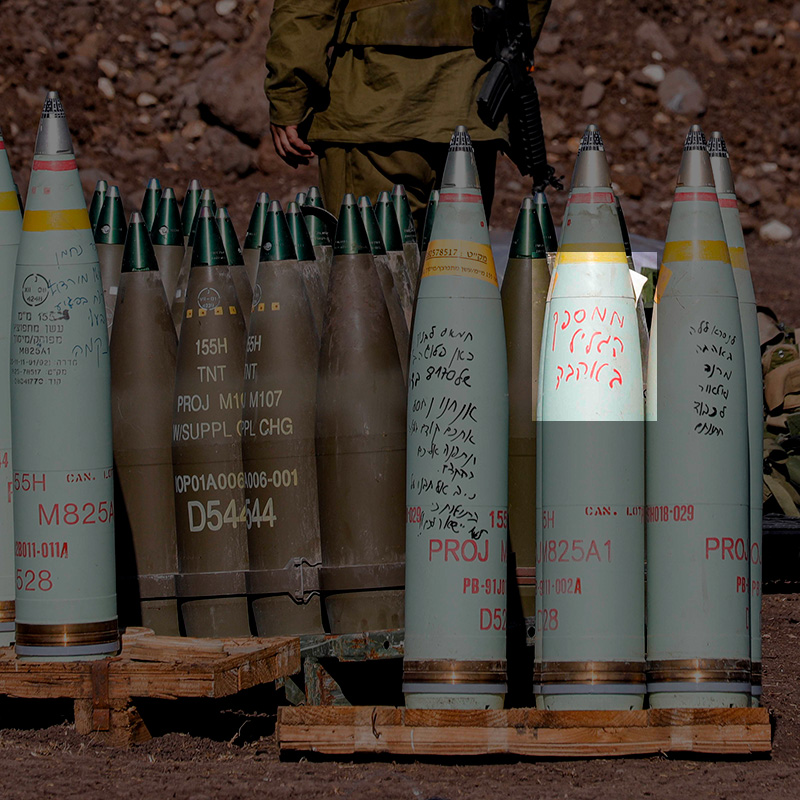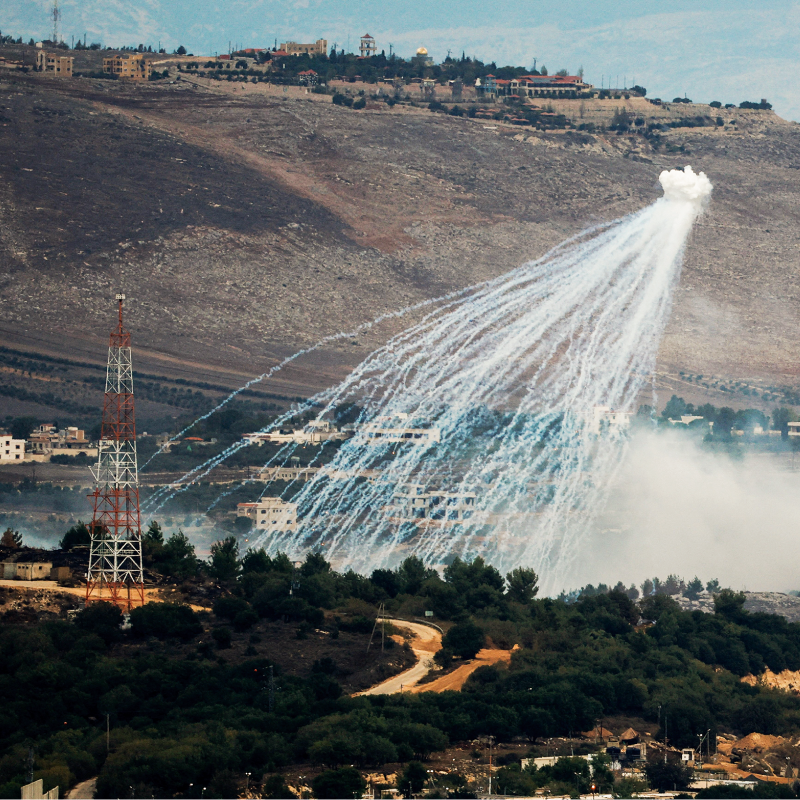On Sunday 5 November, Bashar Taleb, a photographer with AFP News, stands in front of the entrance of the al-Shifa Hospital in Gaza City. At 8:17 AM he points his camera to the sky, along the roof of the Carmel boys’ school, towards the Jerusalem Hospital in the Tel al Hawa neighbourhood, a few kilometres away. A shell explodes in the blue sky, creating a white cloud of smoke with tentacle-like ribbons of smoke floating down in graceful arcs disappearing behind the houses.
What he’d already suspected, has now been confirmed by munitions experts: the projectile he captured above a densely populated area in Gaza City was in fact a white phosphorus shell.


On that particular Sunday morning, 5 November, Taleb takes this picture.
From the entrance of Al-Shifa Hospital, the photographer walked along Shifa-Ezz Eldine Al-Qassam road towards Carmel boys’ school. Just before the junction with Omar Al Mukhtar Street ✖ Taleb took his picture.
The three rooftops on the left in that photo are part of the building with the red roofs opposite the school.
The brick building on the right is the L-shaped building next to the school.
From Taleb’s location and his line of sight, the cloud of white phosphorus must have hovered somewhere over this densely populated area.
“This is white phosphorus, without a doubt”, says Chris Cobb-Smith, a former artillery officer with the British Army, after being shown the picture by NRC. “It’s clearly recognizable by the phosphorus-impregnated pieces of felt scattered by the explosion.” Those pieces of felt cause the ribbons of smoke. As an artillery officer, Cobb-Smith has used white phosphorus in military exercises. He has also trained other soldiers in its use.
Mark Hiznay, a senior researcher in the Arms Division of Human Rights Watch, said: “What is pictured here is an air-burst M825-series 155 mm artillery projectile that contains white phosphorus”. Among other things, he recognizes it by the large number of ‘tentacles’. M825 is the code used by the American Department of Defence for white phosphorus shells.
These white phosphorus shells are just a few of the many kinds of munitions being used in the war on Gaza. But they’re highly controversial, as they can cause severe burns and respiratory problems. Especially if they explode in the air and particles fall in an uncontrolled manner, they can cause serious suffering to civilians. “My concern about the use of white phosphorus, as seen in this photo, is that it is clearly over a densely populated area,” says Cobb-Smith.
Who fired these shells cannot be answered by just this picture. But, says Hiznay: “The only weapon capable of shooting these types of shells is the 155 mm-howitzer.” According to Hiznay, the Israeli army has this weapon at its disposal; the Doher armoured self-propelled howitzer. He adds: “Hamas and other Palestinian groups do not have this weapon.” International news agencies have taken photos in Israel of soldiers standing next to white phosphorus shells and Doher howitzers.
A spokesperson for the Israeli army says: “The main type of smoke-screen shells used by the IDF do not contain white phosphorous. Other smoke-screen shells, with white phosphorus, are not unlawful and many Western militaries possess them, including the IDF. IDF procedures require that such shells are not used in densely populated areas, subject to certain exceptions. This complies and goes beyond the requirements of international law.”
There are international laws regarding the use of white phosphorus, but the question as to whom they apply – and to what extent – has been fruitlessly debated for years. Whether the substance is used lawfully depends in part on the intended military purpose.


This picture was taken in the Israeli region of Galilee, on the border with Lebanon. Israeli soldiers wrote slogans on white phosphorus shells.
This reads: “To [Hezbollah leader] Nasrallah, with love, from Rana and Elor for their wedding.”
This text is hard to read. Its gist: Hamas, Lebanon, here is Brigade B, [number], we will kill you all.
M825A and D528 are codes for white phosphorus.
“From Galilee, with love.”
This distinction is often difficult to make: even if the goal is ‘merely’ to create a smoke screen, injuries can occur, especially when used above densely populated areas. Gazan civilians have such an experience etched in their collective memory: Israel also used white phosphorus in Gaza in 2008 and 2009, resulting in several deaths and injuries. Israel initially denied this.
So it’s not surprising that Gazans are terrified of any kind of smoking projectile that falls from the sky. This can be clearly seen in a video on Instagram, on the grounds of a school of the UN organization UNRWA in the Al-Shati refugee camp. A smoking projectile is seen falling to the ground, people scatter, and some men cover the projectile with buckets of sand. The caption of the video: “The Israeli occupation targeted UNRWA schools [...] with white phosphorus.” The video has more than 400,000 likes.
This video does not show white phosphorus, says Chris Cobb-Smith, but a different type of smoke pattern. “The smoke builds up more slowly than white phosphorus.” Instagram has now labelled the video with the warning that it contains “incorrect information”. But this only happened after it went viral.
Social media are overflowing with such incorrect claims about white phosphorus in this war. Images from other wars, such as those in Syria, are also shared as if they originate from Gaza, often accompanied by the bold claim that Israel is committing war crimes.
Although most claims appear to be incorrect, white phosphorus is indeed being used. In addition to the example in Gaza, NRC also found three cases — in photos and video footage from 21 and 24 October, and 12 November — on the border between Israel and Lebanon, where the fights between the Israeli army and the Lebanese militant movement Hezbollah have increased significantly.
In these cases there will be less controversy, says Stéphane Audrand, a French consultant on weapons and security risks. He, like Cobb-Smith, confirms that white phosphorus can be seen. “Here, white phosphorus is used on open terrain.”


This area is less densely populated.
The round golden dome atop the mountain is the ‘Dome of the Rock’ mosque in Maroun al-Ras, a village in southern Lebanon on the border with Israel.
Satellite images show both the red roofs to the right of the mosque, and the ‘Dome of the Rock’ mosque itself.
Furthermore, the telephone mast can be seen back on the far left.
Because the photographer of this picture most likely used a telephoto lens, the picture has less depth. This distorts the image.
The white phosphorus seems to ignite right in front of the mosque. But in all likelihood, the blast was near the Lebanese village of Yaroun, miles away from the mosque.
“It may be intended to hide Israeli troop movements from Hezbollah’s view,” says the French consultant. “Or to push back Hezbollah. The heat can also confuse the infrared sensors of anti-tank missiles, causing them to veer off course.”
Last month, Human Rights Watch and Amnesty International confirmed that white phosphorus had been used in Gaza and the border region. NOS spoke to Lebanese villagers who say they had to be treated in hospital with breathing problems after these attacks.
The British-Palestinian plastic surgeon Ghassan Abu Sitta tweeted in late October that he had treated a thirteen-year-old child for white phosphorus wounds to the legs at Shifa Hospital. “I recognized it very clearly,” he explained by telephone. “I also saw it here in Gaza in 2009. The tissue had turned white and the wound extended to the bone. I had to remove the dead tissue.”
:strip_icc()/s3/static.nrc.nl/bvhw/files/2023/11/eeffectenogenlongen-1.png|//images.nrc.nl/390uTNEqFL40wLsPtF9EHuDM9xI=/1920x/smart/filters:no_upscale():strip_icc()/s3/static.nrc.nl/bvhw/files/2023/11/eeffectenogenlongen-1.png|//images.nrc.nl/IPoePBxIBjV6nd_9yEc7N2KeQyk=/5760x/smart/filters:no_upscale():strip_icc()/s3/static.nrc.nl/bvhw/files/2023/11/eeffectenogenlongen-1.png)
:strip_icc()/s3/static.nrc.nl/bvhw/files/2023/11/eeffectenogenlongen1x1-1.png|//images.nrc.nl/A4tkxRPHLwCpGWD3E4ls1WAo-88=/1920x/smart/filters:no_upscale():strip_icc()/s3/static.nrc.nl/bvhw/files/2023/11/eeffectenogenlongen1x1-1.png|//images.nrc.nl/WvG5jh8WSCaJxzRcvonC627s-Xc=/5760x/smart/filters:no_upscale():strip_icc()/s3/static.nrc.nl/bvhw/files/2023/11/eeffectenogenlongen1x1-1.png)
Many questions remain unanswered about the use of white phosphorus in Gaza. “White phosphorus is a tool in the toolbox of soldiers seeking to hide from enemy fire in open terrain,” says Cobb-Smith. “One must wonder what the tactical reasoning is for detonating it in the air over a densely populated residential area. I don’t know what a legitimate tactical reason could be.”
AFP photographer Bashar Taleb has now fled to the south of Gaza. “Everything in the city had become a target,” he says by telephone. “The danger was unimaginable. We could no longer do our work.”


This footage was taken during a live stream by Lebanese television channel Al-Mayadeen on 21 October between 17:00 and 18:00.
White phosphorus can be seen being fired.
Behind the smoke, you can see pylons. Those pylons belong to the Israeli military post Tsurit, on the border with Lebanon.
Photos taken from that monument show the pylons from a different angle.


This picture was taken by Lebanese news site Al-Manar. X-user @Akhbarhdod posted the picture on the social network on October 24.
Two masts and a long wall can be seen.
These pylons are near the Israeli Rav Ashi tomb, on the border with Lebanon. The phosphorus grenade explodes over the southern Lebanese village of Hula.
- Text and research
- Hanneke Chin-A-Fo, Pauke van den Heuvel, Lian Hof and Georgia Oost
- Animation and illustration
- Emmelien Stavast
- Photo editing
- Sasja van Diggelen, Wim Lintsen and Angela Luong
- Digital design and technology
- Roos Liefting and Koen Smeets
- Final editing
- Bas Blokker, Anna Vossers, Hans Steketee and Merijn de Waal
- Coordination
- Winny de Jong and Wubby Luyendijk
- With the cooperation of
- Cosette Molijn
/s3/static.nrc.nl/bvhw/files/2023/11/data108089860-2341d5-1.jpg)








